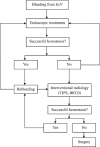Clinical characteristics and efficacy of endoscopic treatment of gastrointestinal ectopic varices: A single-center study
- PMID: 33208560
- PMCID: PMC8083249
- DOI: 10.4103/sjg.SJG_50_20
Clinical characteristics and efficacy of endoscopic treatment of gastrointestinal ectopic varices: A single-center study
Abstract
Background: Ectopic varices (EcVs) may cause massive bleeding, which can be difficult to control, with a high rate of mortality. The purpose of this study was to analyze the clinical characteristics of EcVs and the efficacy of endoscopic treatment.
Methods: From January 2008 to July 2017, the clinical data of 150 patients with EcVs in our center were retrospectively collected and analyzed.
Results: One hundred and fifty patients with EcVs (male 74.7%), with a mean age of: 54.1 ± 14.6 years were included. The prevalence of EcVs was 0.92% in gastrointestinal varices. Cirrhosis was the most common cause of EcVs (67.0%). The rates of bleeding were 57.14%, 4.34%, 30.0%, 33.3%, and 100% in the duodenal varices rectal varices, colonic varices, anastomotic varices, and small bowel varices, respectively. An age under 55 years, varices in the duodenum, and erythema were considered risk factors for EcV bleeding. Endoscopic treatments were performed in 15 patients with EcV bleeding. The follow-up period of the patients who underwent endoscopic treatment ranged from 0.5 to 24 months. The overall rate of treatment success was 73.33% for endoscopic treatment of EcV bleeding. The overall rates of rebleeding and mortality during 2 years were as high as 53.3% and 26.7%, respectively.
Conclusion: Age, erythema, and the location of EcVs are considered risk factors for EcV bleeding, and the rate of bleeding is higher in patients with duodenal varices than in those with other EcVs. Endoscopic treatment is safe, effective, and feasible for controlling EcV bleeding.
Keywords: Clinical characteristics; ectopic varices; endoscopic treatment.
Conflict of interest statement
None
Figures





References
-
- Henry ZH, Caldwell SH. Management of bleeding ectopic varices. Tech Gastrointest Endosc. 2017;19:101–107.
-
- Norton ID, Andrews JC, Kamath PS. Management of ectopic varices. Hepatology. 1998;28:1154–8. - PubMed
-
- Kinkhabwala M, Mousavi A, Iyer S, Adamsons R. Bleeding ileal varicosity demonstrated by transhepatic portography. AJR Am J Roentgenol. 1977;129:514–6. - PubMed
-
- Stephan G, Miething R. [X-ray diagnosis of varicose duodenal changes in poratal hypertension] Radiologe. 1968;8:90–5. - PubMed
-
- Al-Mofarreh M, Al-Moagel-Alfarag M, Ashoor T, Shadoochy F. Duodenal varices. Report of 13 cases. Z Gastroenterol. 1986;24:673–80. - PubMed
MeSH terms
LinkOut - more resources
Full Text Sources
Medical
